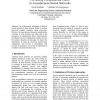Free Online Productivity Tools
i2Speak
i2Symbol
i2OCR
iTex2Img
iWeb2Print
iWeb2Shot
i2Type
iPdf2Split
iPdf2Merge
i2Bopomofo
i2Arabic
i2Style
i2Image
i2PDF
iLatex2Rtf
Sci2ools
APPINF
2003
2003
Preventing Computational Chaos in Asynchronous Neural Networks
One of the primary advantages of artificial neural networks is their inherent ability to perform massively parallel, nonlinear signal processing. However, the asynchronous dynamics underlying the evolution of such networks may often lead to the emergence of computational chaos, which impedes the efficient retrieval of information usually stored in the system’s attractors. In this paper, we discuss the implications of chaos in concurrent asynchronous computation, and provide a methodology that prevents its emergence. Our results are illustrated on a widely used neural network model.
APPINF 2003 | Artificial Neural Networks | Information Technology | Neural Network | Nonlinear Signal Processing |
Related Content
| Added | 31 Oct 2010 |
| Updated | 31 Oct 2010 |
| Type | Conference |
| Year | 2003 |
| Where | APPINF |
| Authors | Jacob Barhen, Vladimir Protopopescu |
Comments (0)

